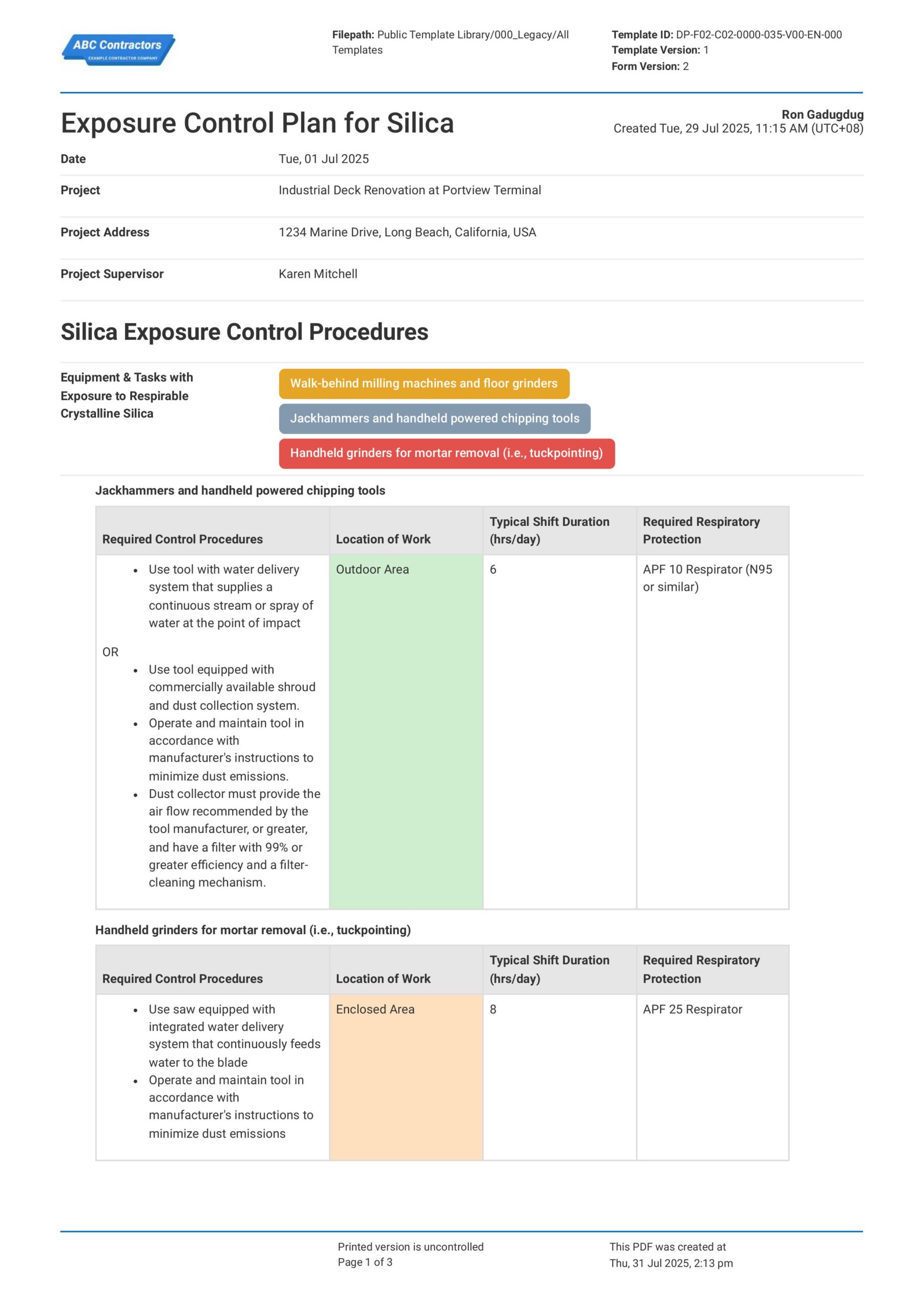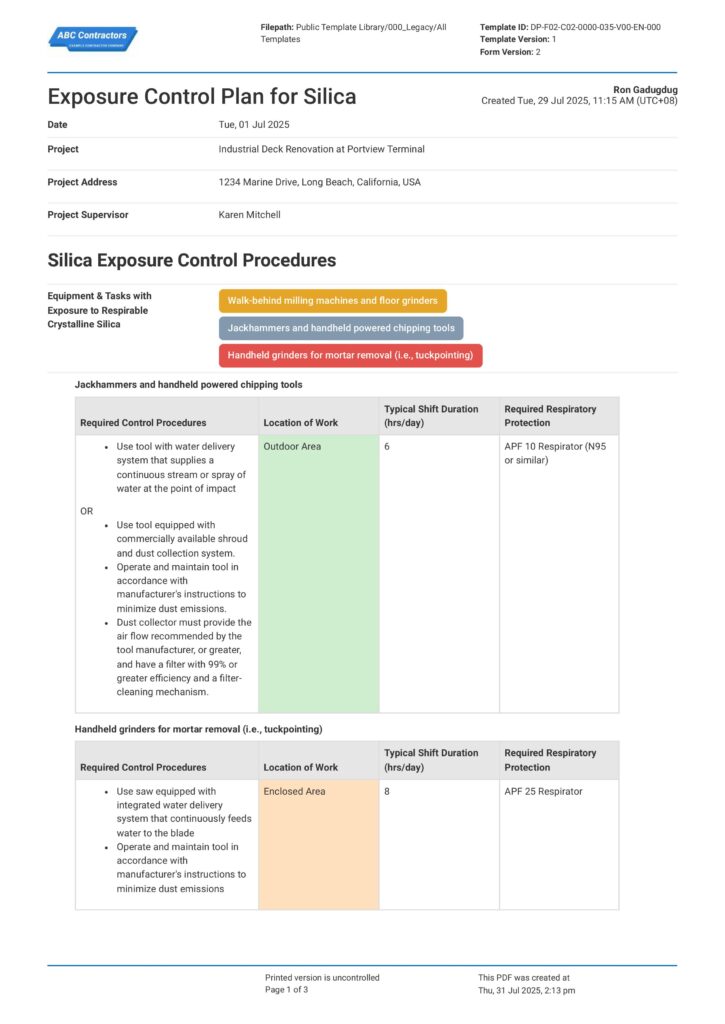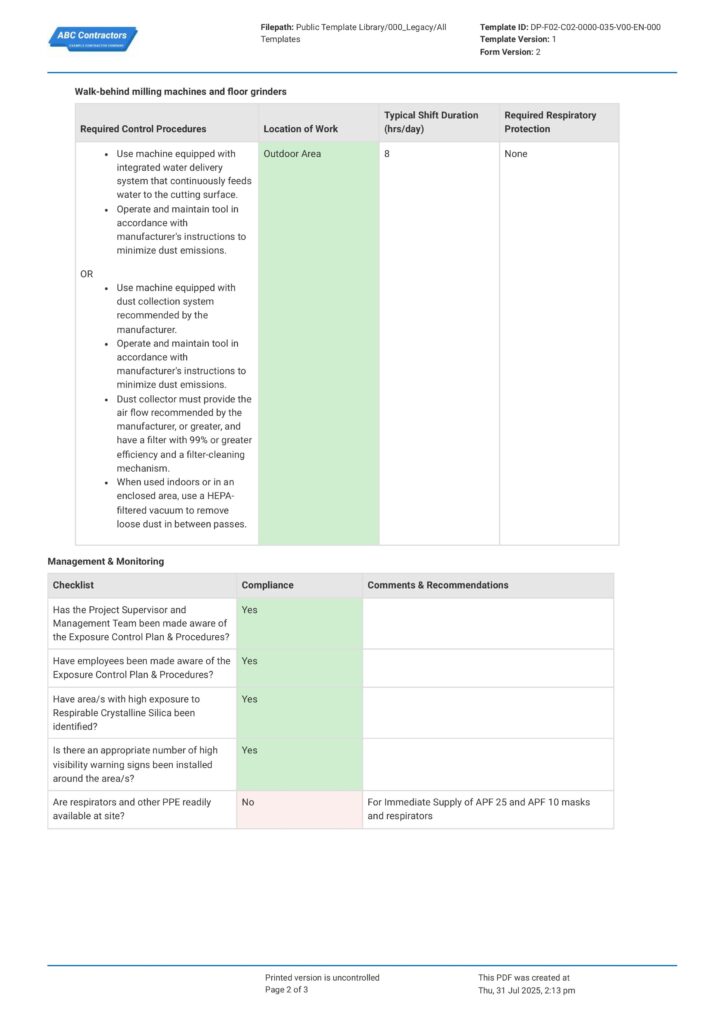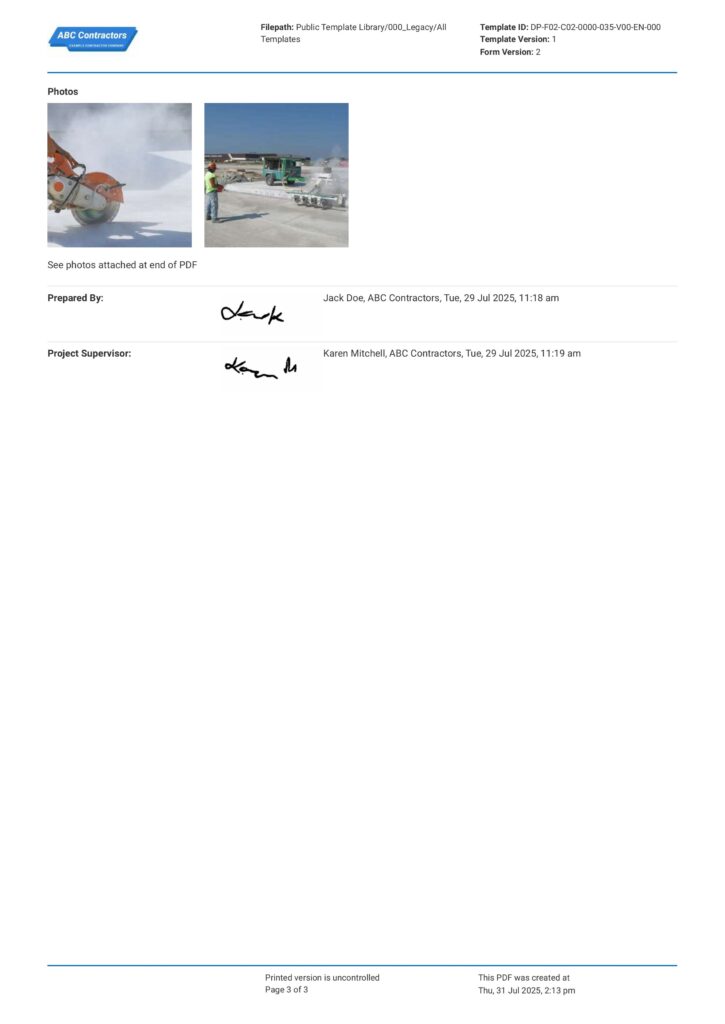Exposure Control Plan for Silica Template
Start with a free 30-day trial. No credit card required.

~10,000 employees
~500 employees
~10 employees
~25,000 employees
~200 employees
~1,500 employees
~20 employees
What is an Exposure Control Plan for Silica?
An Exposure Control Plan for Silica is a formal written document that outlines standard operating procedures that protect workers from exposure to silica dust at the worksite. It is explicitly required by OSHA for employers to create a written exposure control plan when executing tasks such as cutting or drilling materials like concrete, stone, or other masonry.
The main purpose of a silica dust exposure control plan is to identify tasks that expose workers to Respirable Crystalline Silica (RCS) and outline the control methods and safety guidelines for each task. Primarily, a properly constructed exposure plan helps your team identify and implement the correct regulatory control methods, while also serving as a supporting document for tasks like exposure & risk management, health and safety assessments, housekeeping, and worker training.
Compare this Respirable Crystalline Silica Exposure Control Plan to other forms on Word, Excel or PDF
Use this Silica Exposure Control Plan template for free.
Guide to the OSHA Silica Exposure Control Plan
The exposure to silica dust in the form of Respirable Crystalline Silica has shown to be the cause for several diseases contracted from construction sites. In order to protect the long-term health of workers, industry regulatory bodies like OSHA have implemented guidelines that are strictly implemented and complied with. OSHA lists their standards and regulations on written exposure control plans in their Safety & Health Regulations for Construction notice on Toxic and Hazardous Substances 29 CFR 1926.1153 (Construction) & 29 CFR 1910.1053 (General Industry and Maritime).
It is mandated that, when performing work tasks that potentially expose their workers or other parties to respirable crystalline silica, all employers must create and implement a written exposure control plan that contains the following information:
- Description of tasks that involve exposure to Respirable Crystalline Silica
- Engineering control methods, work practices & respiratory protection to limit exposure for each task
- Procedures on housekeeping to limit the level of exposure of employees or other parties
- Procedures to restrict access to work areas to limit the number of employees or other parties exposed and their level of exposure, including exposure due to works of other employers or sole proprietors
For construction sites, employers are also required to designate a competent person to evaluate and implement the exposure control plan, and to inspect the job site for compliance. This responsibility normally falls to the project management & supervisory team. Further, OSHA also requires medical surveillance and check-ups for employees who are regularly exposed to silica dust, as well as proper record keeping and employee training.
Why is Respirable Crystalline Silica Dangerous?
Is crystalline silica dangerous? Performing tasks that include breaking, cutting, or drilling materials like concrete or stone, fine dust is released into the air containing crystalline silica. When inhaled, these particles cannot be naturally processed or otherwise expelled from your body, remaining in your respiratory system, even after you are no longer exposed to silica dust. This leads to irreversible and currently incurable scarring of the lungs, a disease called silicosis. Respirable Crystalline Silica has also been linked to diseases like lung cancer, chronic obstructive pulmonary disease (COPD), and kidney diseases.
However, despite the need for protection against respirable crystalline silica, it can be considered impractical to set high protection standards at certain low levels of exposure. To set uniform standards across construction & general industry, OSHA has recently determined the following exposure levels:
- Action Level (AL) is set at a concentration of respirable airborne respirable crystalline silica of 25 μg/m3, calculated as an 8-hour TWA. This refers to the minimum level where exposure is monitored and protective measures must be implemented, such as wearing of PPE, etc.
- Permissible Exposure Level (PEL) is set at a concentration of respirable airborne respirable crystalline silica of 50 μg/m3, calculated as an 8-hour TWA. This refers to the maximum level of exposure allowed by OSHA. Strict compliance to the control methods listed in Table 1 of 29 CFR 1926.1153. Employees who are exposed to above PEL for 30 days or more are further required to undergo regular medical surveillance.
Frequently Asked Questions
Why is this the best Exposure Control Plan for Silica Template?
Sitemate’s Exposure Control Plan for Silica Template automatically tells you what exposure control methods and respiratory protection OSHA requires for each task, without you needing to read through the regulatory table. You can also manage and monitor the control plan at site with just a few clicks.
Does the template follow the relevant OSHA standards?
Yes - this template was built entirely around the OSHA instruction for hazardous material 29 CFR 1926.1153 (Construction) & 29 CFR 1910.1053 (General Industry and Maritime) for Safety Guidelines on Respirable Crystalline Silica.
Can I edit the content of this exposure control plan template?
Yes - editting the content of the template is easy and intuitive with Dashpivot’s drag-and-drop template builder. Edit the content to capture other data, add your company logo to the header, or even reconfigure the entire document to tailor-fit company specific needs.
Where can I access and edit this exposure control plan?
This plan can be accessed on your phone, tablet, or desktop. Made for the engineer on the go, take this plan to the project site to fill-out and to your office to edit and publish. When you’re done, you can also export the file to PDF or CSV.
Other popular templates you can use and edit for free

Asbestos Management Plan Template
Manage asbestos related risks with this template

Hazardous Material Safety Plan Template
Plan out how to deal with hazardous material and waste

Weekly Safety Inspection Checklist
Never miss an inspection item with this checklist
This plan was generated with Dashpivot software
Streamline your exposure control planning by going digital with Dashpivot.
- Access, edit and complete exposure control & safety plans from any device - mobile, tablet or computer.
- Print, download or send your exposure control & safety plans as perfectly formatted PDF documents with your company logo.
- Store your plans securely online, where they can be searched and found in seconds
- Invite internal and external parties to see, edit and sign off on plans online.
Sitemate builds best-in-class software tools for built world companies.


